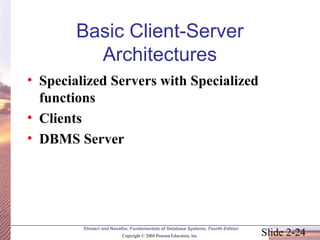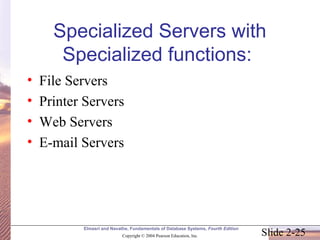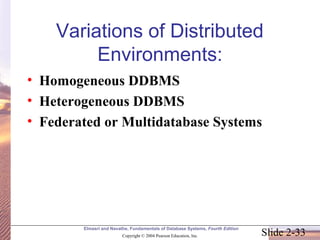Fundamentals of Database system
- 1. Copyright © 2004 Pearson Education, Inc.
- 2. Chapter 2 Database System Concepts and Architecture Copyright © 2004 Pearson Education, Inc.
- 3. Data Models Data Model: A set of concepts to describe the structure of a database, and certain constraints that the database should obey. Data Model Operations: Operations for specifying database retrievals and updates by referring to the concepts of the data model. Operations on the data model may include basic operations and user-defined operations. Elmasri and Navathe, Fundamentals of Database Systems, Fourth Edition Slide 2-3 Copyright © 2004 Pearson Education, Inc.
- 4. Categories of data models Conceptual (high-level, semantic) data models: Provide concepts that are close to the way many users perceive data. (Also called entity-based or object-based data models.) Physical (low-level, internal) data models: Provide concepts that describe details of how data is stored in the computer. Implementation (representational) data models: Provide concepts that fall between the above two, balancing user views with some computer storage details. Elmasri and Navathe, Fundamentals of Database Systems, Fourth Edition Slide 2-4 Copyright © 2004 Pearson Education, Inc.
- 5. History of Data Models Relational Model: proposed in 1970 by E.F. Codd (IBM), first commercial system in 1981-82. Now in several commercial products (DB2, ORACLE, SQL Server, SYBASE, INFORMIX). Network Model: the first one to be implemented by Honeywell in 1964-65 (IDS System). Adopted heavily due to the support by CODASYL (CODASYL - DBTG report of 1971). Later implemented in a large variety of systems - IDMS (Cullinet - now CA), DMS 1100 (Unisys), IMAGE (H.P.), VAX -DBMS (Digital Equipment Corp.). Hierarchical Data Model: implemented in a joint effort by IBM and North American Rockwell around 1965. Resulted in the IMS family of systems. The most popular model. Other system based on this model: System 2k (SAS inc.) Elmasri and Navathe, Fundamentals of Database Systems, Fourth Edition Slide 2-5 Copyright © 2004 Pearson Education, Inc.
- 6. History of Data Models Object-oriented Data Model(s): several models have been proposed for implementing in a database system. One set comprises models of persistent O-O Programming Languages such as C++ (e.g., in OBJECTSTORE or VERSANT), and Smalltalk (e.g., in GEMSTONE). Additionally, systems like O2, ORION (at MCC - then ITASCA), IRIS (at H.P.- used in Open OODB). Object-Relational Models: Most Recent Trend. Started with Informix Universal Server. Exemplified in the latest versions of Oracle-10i, DB2, and SQL Server etc. systems. Elmasri and Navathe, Fundamentals of Database Systems, Fourth Edition Slide 2-6 Copyright © 2004 Pearson Education, Inc.
- 7. Hierarchical Model • ADVANTAGES: • Hierarchical Model is simple to construct and operate on • Corresponds to a number of natural hierarchically organized domains - e.g., assemblies in manufacturing, personnel organization in companies • Language is simple; uses constructs like GET, GET UNIQUE, GET NEXT, GET NEXT WITHIN PARENT etc. • DISADVANTAGES: • Navigational and procedural nature of processing • Database is visualized as a linear arrangement of records • Little scope for "query optimization" Elmasri and Navathe, Fundamentals of Database Systems, Fourth Edition Slide 2-7 Copyright © 2004 Pearson Education, Inc.
- 8. Network Model Elmasri and Navathe, Fundamentals of Database Systems, Fourth Edition Slide 2-8 Copyright © 2004 Pearson Education, Inc. • ADVANTAGES: • Network Model is able to model complex relationships and represents semantics of add/delete on the relationships. • Can handle most situations for modeling using record types and relationship types. • Language is navigational; uses constructs like FIND, FIND member, FIND owner, FIND NEXT within set, GET etc. Programmers can do optimal navigation through the database. • DISADVANTAGES: • Navigational and procedural nature of processing • Database contains a complex array of pointers that thread through a set of records. Little scope for automated "query optimization”
- 9. Schemas versus Instances • Database Schema: The description of a database. Includes descriptions of the database structure and the constraints that should hold on the database. • Schema Diagram: A diagrammatic display of (some aspects of) a database schema. • Schema Construct: A component of the schema or an object within the schema, e.g., STUDENT, COURSE. • Database Instance: The actual data stored in a database at a particular moment in time. Also called database state (or occurrence). Elmasri and Navathe, Fundamentals of Database Systems, Fourth Edition Slide 2-9 Copyright © 2004 Pearson Education, Inc.
- 10. Database Schema Vs. Database State • Database State: Refers to the content of a database at a moment in time. • Initial Database State: Refers to the database when it is loaded • Valid State: A state that satisfies the structure and constraints of the database. • Distinction • The database schema changes very infrequently. The database state changes every time the database is updated. • Schema is also called intension, whereas state is called extension. Elmasri and Navathe, Fundamentals of Database Systems, Fourth Edition Slide 2-10 Copyright © 2004 Pearson Education, Inc.
- 11. Three-Schema Architecture • Proposed to support DBMS characteristics of: • Program-data independence. • Support of multiple views of the data. Elmasri and Navathe, Fundamentals of Database Systems, Fourth Edition Slide 2-11 Copyright © 2004 Pearson Education, Inc.
- 12. Three-Schema Architecture • Defines DBMS schemas at three levels: • Internal schema at the internal level to describe physical storage structures and access paths. Typically uses a physical data model. • Conceptual schema at the conceptual level to describe the structure and constraints for the whole database for a community of users. Uses a conceptual or an implementation data model. • External schemas at the external level to describe the various user views. Usually uses the same data model as the conceptual level. Elmasri and Navathe, Fundamentals of Database Systems, Fourth Edition Slide 2-12 Copyright © 2004 Pearson Education, Inc.
- 13. Three-Schema Architecture Mappings among schema levels are needed to transform requests and data. Programs refer to an external schema, and are mapped by the DBMS to the internal schema for execution. Elmasri and Navathe, Fundamentals of Database Systems, Fourth Edition Slide 2-13 Copyright © 2004 Pearson Education, Inc.
- 14. Data Independence • Logical Data Independence: The capacity to change the conceptual schema without having to change the external schemas and their application programs. • Physical Data Independence: The capacity to change the internal schema without having to change the conceptual schema. Elmasri and Navathe, Fundamentals of Database Systems, Fourth Edition Slide 2-14 Copyright © 2004 Pearson Education, Inc.
- 15. Data Independence When a schema at a lower level is changed, only the mappings between this schema and higher-level schemas need to be changed in a DBMS that fully supports data independence. The higher-level schemas themselves are unchanged. Hence, the application programs need not be changed since they refer to the external schemas. Elmasri and Navathe, Fundamentals of Database Systems, Fourth Edition Slide 2-15 Copyright © 2004 Pearson Education, Inc.
- 16. DBMS Languages • Data Definition Language (DDL): Used by the DBA and database designers to specify the conceptual schema of a database. In many DBMSs, the DDL is also used to define internal and external schemas (views). In some DBMSs, separate storage definition language (SDL) and view definition language (VDL) are used to define internal and external schemas. Elmasri and Navathe, Fundamentals of Database Systems, Fourth Edition Slide 2-16 Copyright © 2004 Pearson Education, Inc.
- 17. DBMS Languages • Data Manipulation Language (DML): Used to specify database retrievals and updates. • DML commands (data sublanguage) can be embedded in a general-purpose programming language (host language), such as COBOL, C or an Assembly Language. • Alternatively, stand-alone DML commands can be applied directly (query language). Elmasri and Navathe, Fundamentals of Database Systems, Fourth Edition Slide 2-17 Copyright © 2004 Pearson Education, Inc.
- 18. DBMS Languages • High Level or Non-procedural Languages: e.g., SQL, are set-oriented and specify what data to retrieve than how to retrieve. Also called declarative languages. • Low Level or Procedural Languages: record-at-a-time; they specify how to retrieve data and include constructs such as looping. Elmasri and Navathe, Fundamentals of Database Systems, Fourth Edition Slide 2-18 Copyright © 2004 Pearson Education, Inc.
- 19. DBMS Interfaces • Stand-alone query language interfaces. • Programmer interfaces for embedding DML in programming languages: • Pre-compiler Approach • Procedure (Subroutine) Call Approach • User-friendly interfaces: • Menu-based, popular for browsing on the web • Forms-based, designed for naïve users • Graphics-based (Point and Click, Drag and Drop etc.) • Natural language: requests in written English • Combinations of the above Elmasri and Navathe, Fundamentals of Database Systems, Fourth Edition Slide 2-19 Copyright © 2004 Pearson Education, Inc.
- 20. Other DBMS Interfaces • Speech as Input (?) and Output • Web Browser as an interface • Parametric interfaces (e.g., bank tellers) using function keys. • Interfaces for the DBA: • Creating accounts, granting authorizations • Setting system parameters • Changing schemas or access path Elmasri and Navathe, Fundamentals of Database Systems, Fourth Edition Slide 2-20 Copyright © 2004 Pearson Education, Inc.
- 21. Database System Utilities • To perform certain functions such as: • Loading data stored in files into a database. Includes data conversion tools. • Backing up the database periodically on tape. • Reorganizing database file structures. • Report generation utilities. • Performance monitoring utilities. • Other functions, such as sorting, user monitoring, data compression, etc. Elmasri and Navathe, Fundamentals of Database Systems, Fourth Edition Slide 2-21 Copyright © 2004 Pearson Education, Inc.
- 22. Other Tools • Data dictionary / repository: • Used to store schema descriptions and other information such as design decisions, application program descriptions, user information, usage standards, etc. • Active data dictionary is accessed by DBMS software and users/DBA. • Passive data dictionary is accessed by users/DBA only. • Application Development Environments and CASE (computer-aided software engineering) tools: • Examples – Power builder (Sybase), Builder (Borland) Elmasri and Navathe, Fundamentals of Database Systems, Fourth Edition Slide 2-22 Copyright © 2004 Pearson Education, Inc.
- 23. Centralized and Client-Server Architectures • Centralized DBMS: combines everything into single system including- DBMS software, hardware, application programs and user interface processing software. Elmasri and Navathe, Fundamentals of Database Systems, Fourth Edition Slide 2-23 Copyright © 2004 Pearson Education, Inc.
- 24. Basic Client-Server Architectures • Specialized Servers with Specialized functions • Clients • DBMS Server Elmasri and Navathe, Fundamentals of Database Systems, Fourth Edition Slide 2-24 Copyright © 2004 Pearson Education, Inc.
- 25. Specialized Servers with Specialized functions: • File Servers • Printer Servers • Web Servers • E-mail Servers Elmasri and Navathe, Fundamentals of Database Systems, Fourth Edition Slide 2-25 Copyright © 2004 Pearson Education, Inc.
- 26. Clients: • Provide appropriate interfaces and a client-version of the system to access and utilize the server resources. • Clients maybe diskless machines or PCs or Workstations with disks with only the client software installed. • Connected to the servers via some form of a network. (LAN: local area network, wireless network, Elmasri and Navathe, Fundamentals of Database Systems, Fourth Edition Slide 2-26 Copyright © 2004 Pearson Education, Inc. etc.)
- 27. DBMS Server • Provides database query and transaction services to the clients • Sometimes called query and transaction servers Elmasri and Navathe, Fundamentals of Database Systems, Fourth Edition Slide 2-27 Copyright © 2004 Pearson Education, Inc.
- 28. Two Tier Client-Server Architecture • User Interface Programs and Application Programs run on the client side • Interface called ODBC (Open Database Connectivity – see Ch 9) provides an Application program interface (API) allow client side programs to call the DBMS. Most DBMS vendors provide ODBC drivers. Elmasri and Navathe, Fundamentals of Database Systems, Fourth Edition Slide 2-28 Copyright © 2004 Pearson Education, Inc.
- 29. Two Tier Client-Server Architecture • A client program may connect to several DBMSs. • Other variations of clients are possible: e.g., in some DBMSs, more functionality is transferred to clients including data dictionary functions, optimization and recovery across multiple servers, etc. In such situations the server may be called the Data Server. Elmasri and Navathe, Fundamentals of Database Systems, Fourth Edition Slide 2-29 Copyright © 2004 Pearson Education, Inc.
- 30. Three Tier Client-Server Architecture • Common for Web applications • Intermediate Layer called Application Server or Web Server: • stores the web connectivity software and the rules and business logic (constraints) part of the application used to access the right amount of data from the database server • acts like a conduit for sending partially processed data between the database server and the client. • Additional Features- Security: • encrypt the data at the server before transmission • decrypt data at the client Elmasri and Navathe, Fundamentals of Database Systems, Fourth Edition Slide 2-30 Copyright © 2004 Pearson Education, Inc.
- 31. Classification of DBMSs • Based on the data model used: • Traditional: Relational, Network, Hierarchical. • Emerging: Object-oriented, Object-relational. • Other classifications: • Single-user (typically used with micro-computers) vs. multi-user (most DBMSs). • Centralized (uses a single computer with one database) vs. distributed (uses multiple computers, multiple databases) Elmasri and Navathe, Fundamentals of Database Systems, Fourth Edition Slide 2-31 Copyright © 2004 Pearson Education, Inc.
- 32. Classification of DBMSs Distributed Database Systems have now come to be known as client server based database systems because they do not support a totally distributed environment, but rather a set of database servers supporting a set of clients. Elmasri and Navathe, Fundamentals of Database Systems, Fourth Edition Slide 2-32 Copyright © 2004 Pearson Education, Inc.
- 33. Variations of Distributed Environments: • Homogeneous DDBMS • Heterogeneous DDBMS • Federated or Multidatabase Systems Elmasri and Navathe, Fundamentals of Database Systems, Fourth Edition Slide 2-33 Copyright © 2004 Pearson Education, Inc.

































